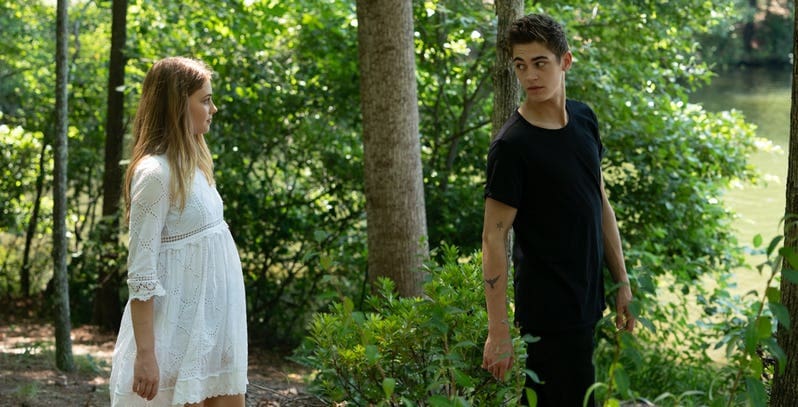Written by Tom Moore
Attempting to adapt the Y.A. romance novel of the same name by Anna Todd, After instead creates a romance film full of shallow characters, distracting design choices, and material that had me chuckling for all the wrong reasons.
For the most part, the film follows the incredibly cliché plot of a sweet wholesome girl, Tessa (Josephine Langford), who meets a misunderstood bad boy, Hardin (Hero Fiennes Tiffin). Obviously, they disagree and bicker at first, but quickly fall in love for basically no reason and feel inseparable without one another. From there, they basically deal with “forbidden love” because of how everyone else sees them and go through rough patches because of, you know, plot reasons as their bond is tested.
After’s initial signs of issues stem from how seriously it takes itself. The film honestly thinks of itself as high-brow and thoughtful at times but doesn’t realize how cliché it is or how stupid the dialogue is. Pretty much every character just spouts predictable, groan-inducing lines that only spark in your head other, probably better, films. There’s no real sense of the passage of time, so decisions that Tessa and Hardin make felt rushed and had me squinting my eyes at the screen in both disbelief and confusion. Frankly, I just kept question how many dumb, cliché decisions these characters were going to make only to be laughing at how ridiculous things got.
Worst of all, the film’s clear high-brow intentions have its characters constantly quoting passages from and comparing themselves to literary romance masterpieces. Pride and Prejudice, The Great Gatsby and many others are named and discussed in the film and it was baffling to think that the film thinks its characters are comparable.
Comparing the depth of characters from Pride and the Prejudice to After is like comparing a vast ocean to a puddle that forms after a light rain. Langford’s Tessa is probably one of the better parts of the movie, as its clear Langford is trying to create internal struggle within Tessa, but just isn’t getting any help from anyone else. Most of the other characters are forgettable, so much so that when their names popped up in conversation, I struggled to remember who they were. Worse, the one connection between Tessa and Hardin, Landon (Shane Paul McGhie), is literally a walking plot device. He’s pretty much there just to motivate Tessa to talk to Hardin and there’s no depth to his character whatsoever. There are some nice themes about change and people’s own desires, even if the film barely acknowledges them, and I could at least take Tessa seriously unlike Hardin, as every time he appears on-screen, this immediately pops into my head:
Now, I don’t know if it’s just from bad direction or Tiffin’s acting, but Hardin is probably the most stereotypical, angsty bad boy I’ve ever seen and he is impossible to take seriously. There was actually a point where I could hear someone whispering, “Oh my god, he’s like a psychopath,” and I immediately thought the same thing. There’s no emotional range to Hardin because while his face sometimes emotes, his dialogue doesn’t; so, it comes off like he doesn’t care about anything even in moments where he says he does. Not to mention, he’s literally the embodiment of every stupid stereotype given to “bad boy” characters that’s made fun of in something like the “Moody’s Point” skits from The Amanda Show.
He likes his coffee black, sits on rooftops when he likes to get his angst on, hates his parents, comes off like a slacker in school, and the coup de grâce, he enjoys the silence of his secret hideout to block out the world. He even only has clothes that are either just black or have bands like Pink Floyd and the Ramones on them. The film tries to create this troubled backstory with his parents and friends, but it never amounts to anything and completely fades out when the film’s “style” gets in the way.
Where Hardin always wears black, Tessa literally wears white or some kind of bright color throughout the film to represent her purity. It’s not bad or uncommon for filmmakers to have their characters be represented through colors, but After’s color representation is so obvious and blatant that it’s incredibly distracting. Even the score is oddly distracting because of how off it is and there’s even a moment where Tessa realizes something bad and the score feels like it belongs more in a Jordan Peele horror flick than in After. The worst part, though, is the film’s overuse of montages and current music to try to make its characters more “fun” and “romantic” rather than use actual dialogue between them.
Considering that Tessa and Hardin both love books, I find it puzzling that the film thinks that montages with no dialogue are the best way for viewers to experience their relationship. If Tessa were to question Hardin on why he wears black all the time or why they like to quote books so much, it would have led to more entertaining banter that develops their relationship and breathes some much-needed life into its characters. However, the film instead just displays why you can’t make the same old, formulaic YA romance movie anymore.
The film’s only redeeming quality is that it’s so bad that’s it’s kind of entertaining to watch and with all of its clichés and laughably bad moments, After is the kind of movie you can make a drinking game out of. However, drink responsibly because the film clichés happen so often, you could be in deep trouble early on.
Rating: 3/10



